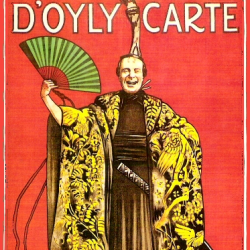
Mikado on Tour
Posted 1 May 2016
The Mikado received its first performance in Scotland on 4 January 1886, at Her Majesty's Theatre, Dundee. After two weeks there and one in Aberdeen (also Her Majesty's), the company moved to Glasgow's Royalty Theatre for two weeks, ending this Scottish tour with a fortnight at Edinburgh's Royal Lyceum. Mr Richard D'Oyly Carte's Opera Company did not yet tour with duplicates of its lavish London scenery, relying instead on the work of local craftsmen. However, the high-quality Japanese-style costumes created by Wilhelm, using Liberty fabrics, were replicated to make the touring production as authentic as possible.
The critics may not have recognised the quality of the work as quickly as did theatre audiences, but the popular assessment won, and it was within a few weeks of the mid-March London opening that the first ensembles set out on tour, marked by letters to distinguish them. So the E company opened in May 1885, reaching Southampton on 21 September and as far north as Paisley the following March. The larger D company arrived in Portsmouth on 4 August, and this was the team that reached Liverpool for Christmas and New Year, did the seven-week Scottish circuit detailed above, and returned south via Newcastle. Later stops included both Belfast (10 May) and Bristol (7 June).
In addition to the two companies touring Britain, D’Oyly Carte soon had six groups performing in North America. So in the week commencing 16 January 1886, D was in Aberdeen; E in Halifax and Keighley (three nights each); G in New York; H Boston; I Philadelphia; K San Francisco; L touring New England and M in Canada. When the G team returned in the spring it appeared in Liverpool and Manchester before heading off to the continent.
The Autumn 1891 tour took place under the cloud of a major breakdown between Gilbert on the one hand and Sullivan and D'Oyly Carte on the other. With no new work on the horizon, The Mikado was revived and sent on tour in repertoire with the two more recent successes, The Yeomen of the Guard and The Gondoliers. The Scottish leg of this tour saw a fifth venue added, when the Aberdeen week was interrupted to give a Command Performance of The Mikado for Queen Victoria at Balmoral. While this was a great success, the train back to Aberdeen did not reach the city until 4.30am, with two exhausting performances of The Gondoliers scheduled for later in the day.
A prosperous touring routine continued up to the outbreak of World War I in 1914. Every centre of population had at least one theatre that could accommodate the Gilbert and Sullivan repertoire. Between the wars, the major performers became household names and began to make complete recordings. The principal comedian during these years, Henry Lytton, even received a knighthood. However, the 1920s also saw the start of a rapid decline in the number of theatres available, as the craze for cinema seized the country. This issue assumed crisis proportions in the 1950s with the onslaught of television. In Scotland the most obvious early casualty was Dundee, previously an important touring venue. The D'Oyly Carte company – just one company now – continued to visit the major cities, usually staying for two or even three weeks. This pattern continued into the 1970s.
Gilbert died in 1911 and the copyright on all the Savoy Operas expired fifty years later, with D'Oyly Carte losing its monopoly. Sadler's Wells was the first company to take up the challenge. After Iolanthe in 1962, its Mikado, directed by Douglas Craig and designed by Peter Rice, toured the following year, reaching the Glasgow Empire with a cast that included David Hillman (Nanki-Poo), Elizabeth Robson (Yum-Yum) and Derek Hammond Stroud (Ko-Ko).
The D'Oyly Carte replied to this challenge by engaging Anthony Besch to revamp its staging in famous designs by Charles Ricketts. This production was preserved on film. The 1960s were a particularly good era for the D'Oyly Carte. Isidore Godfrey, Musical Director for 40 years, was still the chief conductor, and the roster of soloists on various visits included Gillian Knight (Katisha), Valerie Masterson (Yum-Yum), Philip Potter (Nanki-Poo), John Reed (Ko-Ko), Kenneth Sandford (Pooh-Bah) and Donald Adams (The Mikado).
Since then there have been several more notable professional stagings. The New Sadler's Wells Opera Company, established at that London theatre to perform operetta, toured a Mikado production directed by Christopher Renshaw and designed by Tim Goodchild (a Japanese tea-cup theme). This reached as far north as Aberdeen in 1986.
The D'Oyly Carte Opera Company, having been dormant for several years following the death of Dame Bridget D'Oyly Carte, the last in the family line, emerged in 1989 with a sepia-tinted production directed by satirist John Wells and designed by Eileen Diss (sets) and Jessica Gwynne (costumes). The singers included Eric Roberts (Ko-Ko), Malcolm Rivers (Pooh-Bah) and Vivien Tierney (Yum-Yum). This was followed in 1992 by a new look at the work, very black and white, directed by Andrew Wickes.
The reformed Carl Rosa company toured an enjoyable production between 2002 and 2005. Simon Butteriss was Ko-Ko, with Linda Ormiston and Nuala Willis as Katisha, Steven Page in the title role. They were able to take advantage of the recent Mike Leigh film Topsy-Turvy, about the creation of The Mikado. For this enterprise a complete recreation of the original staging had been attempted. Those sets and costumes were now made available, so, as in 1886, the singers, conducted by Martin Handley and directed by Eric Roberts and Peter Mulloy, wore costumes based on the creations by Wilhelm. This time they also had colourful sets derived from those designed in 1885 by Hawes Craven.
Archive
2025
December
2024
November
March
2023
November
March
January
2022
August
July
2019
October
2018
September
February
2017
November
2016
November
October
September
May
March
February
2015
December
October
September
March
2014
October
March
2013
November
February
2011
December
November
September
August
June